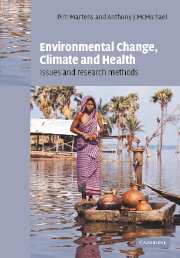Book contents
- Frontmatter
- Contents
- List of contributors
- Foreword
- 1 Global environmental changes: anticipating and assessing risks to health
- 2 Historical connections between climate, medical thought and human health
- 3 The contribution of global environmental factors to ill-health
- 4 Surprise, nonlinearity and complex behaviour
- 5 Epidemiological and impacts assessment methods
- 6 Retrospective studies: analogue approaches to describing climate variability and health
- 7 Detecting the infectious disease consequences of climate change and extreme weather events
- 8 Integrated Assessment modelling of human health impacts
- 9 Remote sensing, GIS and spatial statistics: powerful tools for landscape epidemiology
- 10 Monitoring the health impacts of global climate change
- 11 Epidemiology, environmental health and global change
- 12 Dealing with scientific uncertainties
- Index
- Plate section
- References
9 - Remote sensing, GIS and spatial statistics: powerful tools for landscape epidemiology
Published online by Cambridge University Press: 28 July 2009
- Frontmatter
- Contents
- List of contributors
- Foreword
- 1 Global environmental changes: anticipating and assessing risks to health
- 2 Historical connections between climate, medical thought and human health
- 3 The contribution of global environmental factors to ill-health
- 4 Surprise, nonlinearity and complex behaviour
- 5 Epidemiological and impacts assessment methods
- 6 Retrospective studies: analogue approaches to describing climate variability and health
- 7 Detecting the infectious disease consequences of climate change and extreme weather events
- 8 Integrated Assessment modelling of human health impacts
- 9 Remote sensing, GIS and spatial statistics: powerful tools for landscape epidemiology
- 10 Monitoring the health impacts of global climate change
- 11 Epidemiology, environmental health and global change
- 12 Dealing with scientific uncertainties
- Index
- Plate section
- References
Summary
Acronyms
AATSR Advanced Along Track Scanning Radiometer
ADEOS Advanced Earth Observation Satellite
ALOS Advanced Land Observing Satellite
ARIES Australian Resource Information & Environment Satellite
ASTER Advanced Spaceborne Thermal Emission & Reflection Radiometer
AVHRR Advanced Very High Resolution Radiometer
AVIRIS dvanced Visible and Infrared Imaging Spectrometer
AVNIR Advanced Visible & Near Infrared Radiometer
CBERS China Brazil Earth Resources Satellite
ENVISAT Environmental Satellite
EO-1 Earth Orbiter-1
ERS ESA (European Space Agency) Remote Sensing
ETM+ Enhanced Thematic Mapper (Landsat)
GLI Global Imager
IRS Indian Remote Sensing Satellite
LISS Linear Imaging Self Scanning System
MARA Mapping Malarial Risk in Africa
MODIS Moderate Resolution Imaging Spectro Radiometer
MSS Multispectral Scanner
NOAA National Oceanographic & Atmospheric Administration
PAN Panchromatic
RS Remote Sensing
SAR Synthetic Aperture Radar
SPOT Système Pour l'Observation de la Terre
TM Thematic Mapper (Landsat)
WiFS Wide Field Scanner
XS Multispectral (SPOT)
Introduction
There has been much speculation about the potential impacts of climate change on the map of human health, particularly on the patterns of vector-borne diseases (e.g. Longstreth & Wiseman, 1989; WHO, 1990; Dobson & Carper, 1992; Shope, 1992; Kovats, 2000; Chapters 7 & 8). The impact of climate change on the transmission patterns of these diseases can be both direct (e.g. effect of changes in precipitation on populations of arthropod vectors) and indirect (e.g. human population dynamics and their effects on exposure risk, changes in vegetation, hydrology and other landscape features).
- Type
- Chapter
- Information
- Environmental Change, Climate and HealthIssues and Research Methods, pp. 226 - 252Publisher: Cambridge University PressPrint publication year: 2002
References
- 1
- Cited by



